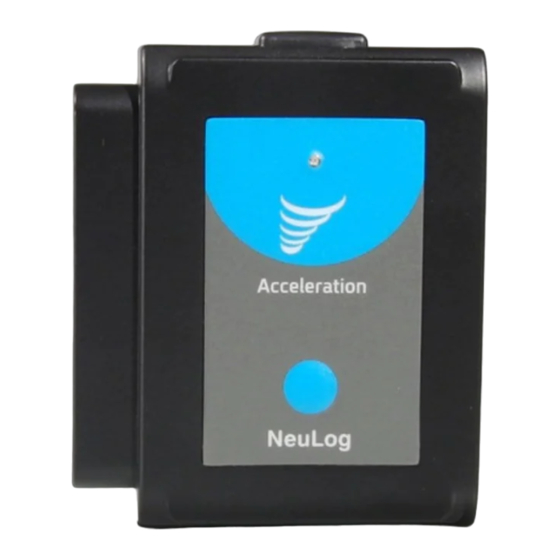
Table of Contents
Advertisement
Quick Links
NeuLog sound logger sensor
NUL-212
The NeuLog sound sensor can be used for any science experiment which involves
either sound intensity or sound wave measurements such as in the fields of Physics,
Mechanics, Biology, Environmental Science, Acoustics, etc.
The sensor comes pre-calibrated so you can start experimentation right out of the box
using this guide.
Among hundreds of possible experimental subjects that can be studied with the NUL-
212 sensor are: wave theory, sound pressure, sounds intensity, sound theory (pitches,
frequencies, etc.), wave interference, and many more.
The sound sensor's measurement units are:
Decibel (dB): A measurement unit that shows intensity (loudness of sound). This is a
logarithmic unit.
Arbitrary analog units (Arb): An arbitrary unit to demonstrate waves, frequencies and
periods.
Quick start procedure:
PC or Mac Computer
Materials needed:
NUL-212 Sound Sensor
USB-200 USB Module
USB to mini USB cable (included with the USB-200 module)
Your sound sensor needs to be connected to a USB-200 module. The USB-200
module then connects to a computer via a USB to mini-USB cable. Please note that
you cannot plug the sound sensor directly into the computer.
The browser based application can be downloaded for free at
well as a full application user guide.
Choose "Downloads" on the main menu and then choose "Software and Application".
NEULOG SOUND LOGGER SENSOR GUIDE
Procedure:
1.
Install the NeuLog application.
2.
Connect the USB-200 module to the PC or Mac.
3.
Connect the sound sensor to the USB-200 module (they directly plug together).
Please note that no calibration is required for this sensor.
4.
Open the NeuLog application by clicking on the shortcut on the screen.
5.
Once a sound sensor module box appears on the left side of the screen the
probe has been automatically identified and you can begin experimentation.
If the sound sensor is not automatically identified, click the "Search for sensors"
6.
icon to find the sensor.
Click on the "On-line experiment" icon; this will open a graph below.
7.
Click on the "Module setup" button located in the sound sensor module box to
8.
change the sensor's settings if need be.
9.
Click on the "Experiment setup" icon to change the experiment settings if need
be (experiment duration for example).
10.
The sound sensor will give a live reading in its module box to the left of the
screen while plugged in.
To run an experiment and collect data click the "Run experiment" icon.
11.
To end data collection early, click the "Stop experiment" icon.
12.
Tablet, smart phone device
Materials needed:
NUL-212 Sound Sensor
WIFI-201 WiFi Module
BAT-200 Battery
Your sound sensor needs to be connected to a WIFI-201 module. The WIFI-201
module will create a closed NeuLog WiFi network which will stream the NeuLog data
to a device of your choosing. Once your device is wirelessly connected to the NeuLog
network, you can run experiments and collect data through a browser of your
choosing.
Procedure:
1.
Connect the sound sensor directly to the left side of a WIFI-201 module (no
wires required).
www.NeuLog.com
as
2.
Connect a BAT-200 module to the right side of the WIFI-201 module.
3.
Although not required, we recommend plugging the BAT-200 to an outlet using a
USB to mini USB charger (such as a typical cell phone charger). The WIFI-201
module will run for 60-90 minutes (depending on the sensor) without being
plugged in.
Advertisement
Table of Contents

Summary of Contents for NeuLog NUL-212
- Page 1 NeuLog WiFi network which will stream the NeuLog data NUL-212 Sound Sensor to a device of your choosing. Once your device is wirelessly connected to the NeuLog USB-200 USB Module network, you can run experiments and collect data through a browser of your ...
- Page 2 To run an experiment and collect data press the run icon (little green person). turns blue; this can take up to one minute. Take your tablet or smart phone, go to the WiFi settings and select the NeuLog network (NeuLog0184 for example) which matches the ID found on the back of Off-line experiments the WIFI-201 module (0184 for example).
- Page 3 ADC resolution 12 bit in each plastic NeuLog body. This technology allows the sensor to collect and then Accuracy ± 2 dB store the digital data in the correct scientific units ( F, Lux, %, ppm, for example).
- Page 4 This design of the sensor enables its use as two sensors: microphone and sound waves. Maintenance and storage: V11042014 Never submerge the NeuLog plastic body in any liquid. Do not allow liquid into the sound sensor’s body. After use, gently wipe away any foreign material from the sound sensor.













Need help?
Do you have a question about the NUL-212 and is the answer not in the manual?
Questions and answers